Pit Bulls Are Identifiable Meme Campaign
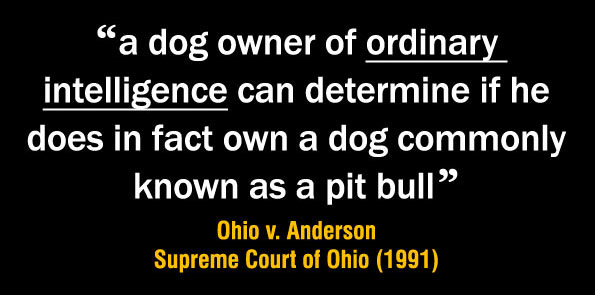
DogsBite.org - For 25 years appellate courts have ruled that a dog owner of ordinary intelligence can identify a pit bull (See: Ohio v. Anderson, 1991). In addition to this, the high courts have ruled that scientific precision is not required when determining the breed (See: Colorado Dog Fanciers v. Denver, 1991). Yet still the myth persists ad nauseam -- pushed by the Pit Bull Propaganda Machine, pit bull advocates, animal groups and more -- that it is impossible to identify a pit bull.
Readers are familiar with this myth, which has variations like, "it is impossible to identify a pit bull" and "pit bulls can't be identified," and the mothership motto, "there is no such thing as a pit bull." In a series of 8 memes, directly quoting high court rulings, we highlight how the high courts have ruled on this subject. The courts have ruled that a pit bull is a breed of dog with distinctive traits that can be recognized by its physical appearance by a dog owner of ordinary intelligence.
"Pit bull dogs possess unique and readily identifiable physical and behavioral traits which are capable of recognition both by dog owners of ordinary intelligence..."
- Ohio v. Anderson, Supreme Court of Ohio (1991)
The series of memes are for readers to share on Facebook, Twitter, other social media networks and commenting platforms. They are especially effective as Facebook photo comments when debating "breed enthusiasts" who flock to Facebook to comment after a serious or fatal pit bull attack to defend the breed and disseminate false myths. You do not need to engage with these pit bull defenders, just post one of our memes as a photo comment -- no other words are needed.
Why This Myth Must Be Destroyed
The myth that it is impossible to identify a pit bull or that only an "expert" with a suitcase of science can achieve this task must be discredited. Nowhere do the high courts state that "expert" knowledge is necessary to identify a pit bull. Specifically, the high courts state, "a dog owner of ordinary intelligence can determine if he does in fact own a dog commonly known as a pit bull" and the "American pit bull terrier is a recognized breed of dog readily identifiable by laymen."
"The trial court found that the American Pit Bull Terrier is a recognized breed of dog readily identifiable by laymen."
- Garcia v. Village of Tijeras, Court of Appeals of New Mexico (1988)
Our memes are big and bold because we are shouting to the public: Yes you, a dog owner of ordinary intelligence can identify a pit bull! The high courts have clearly stated this. Do not allow this false myth to lead your confidence astray. Moreover, when faced with anyone who claims that a pit bull cannot be identified, whip out one of our high court memes -- it cannot be denied! So be bold, have confidence and help us dismantle this myth, long ago debunked by the high courts!
In Closing: It's an Old Recycled Myth
The weighty curse of this false myth cannot be expressed enough. While it is jarring to see the many pit bull specific rescues who claim, "there is no such thing as a pit bull" while operating a pit bull specific foundation or pit bull specific adoption program, understand that this claim is very old. All four of the high court decisions that were used in these memes (from 1988 to 1991) involved pit bull owners claiming in one way or another that a pit bull is "not a breed" or is "not identifiable."
This is how we think Judge Judy would respond to the Bryan Bickell Foundation's shenanigans.
Pit Bull Identification Meme Campaign
Suggested hashtags: #PitBullsAreIdentifiable | #ICanIDaPitBull
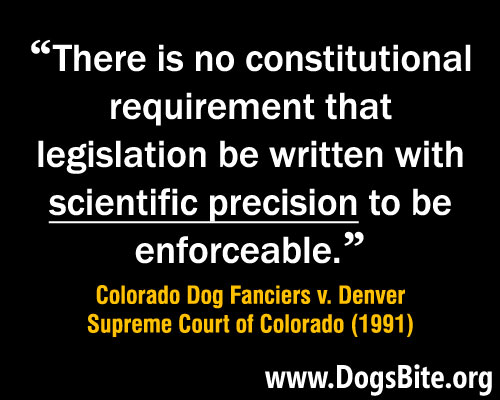
Colorado Dog Fanciers v. Denver, 820 P. 2d 644 - Colo: Supreme Court 1991

Ohio v. Anderson, 57 Ohio St. 3d 168 - Ohio: Supreme Court 1991

Ohio v. Anderson, 57 Ohio St. 3d 168 - Ohio: Supreme Court 1991
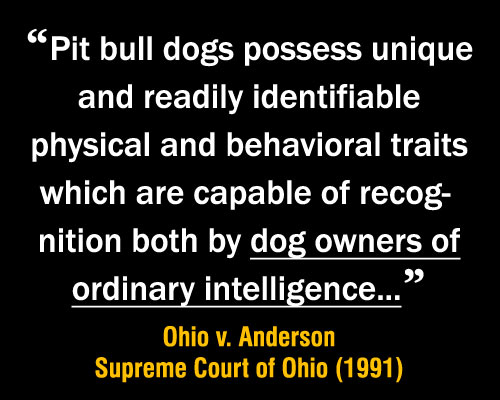
Ohio v. Anderson, 57 Ohio St. 3d 168 - Ohio: Supreme Court 1991
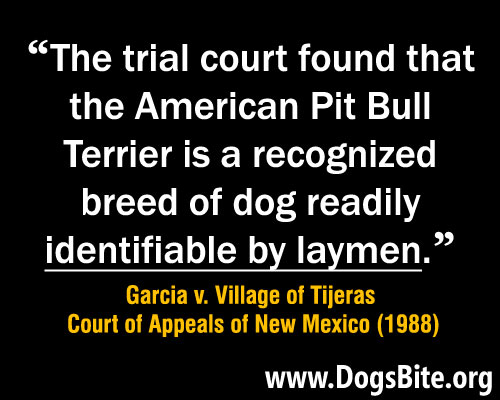
Garcia v. Village of Tijeras, 767 P. 2d 355 - NM: Court of Appeals 1988
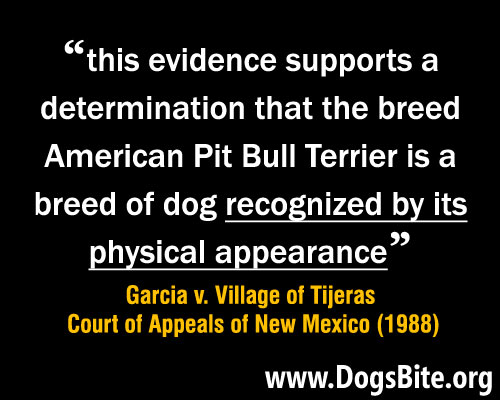
Garcia v. Village of Tijeras, 767 P. 2d 355 - NM: Court of Appeals 1988
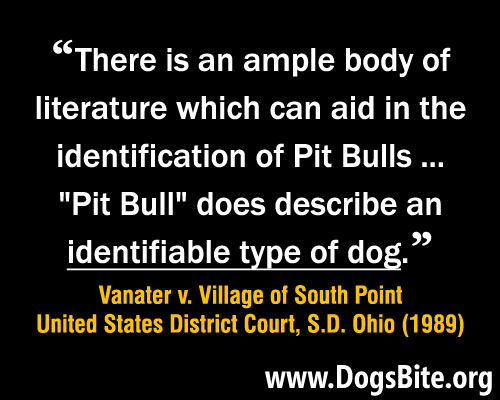
Vanater v. Village of South Point, 717 F. Supp. 1236 - Dist. Court, SD Ohio 1989
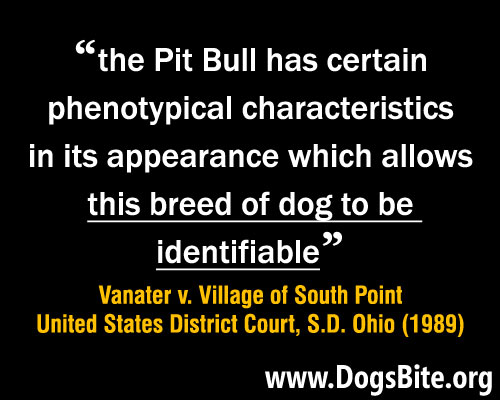
Vanater v. Village of South Point, 717 F. Supp. 1236 - Dist. Court, SD Ohio 1989
Additional Analysis
To demonstrate the knowledge required to identify a pit bull, the high courts were specific: "An ordinary person could easily refer to a dictionary, a dog buyer's guide or any dog book for guidance and instruction" (Vanater, 1989), "Consistent and detailed descriptions of the pit bull dog may be found in canine guidebooks, general reference books" (Ohio, 1991), and "the commonly available knowledge of dog breeds typically acquired by potential dog owners" (Toledo, 2007).
We list these early high court decisions in chronological order below leading up to 2008, when the U.S. Supreme Court rejected Tellings v. Toldeo. Back in the late 80s and early 90s there was no Internet. By today's standards, if you can Google or if you have an iPhone, you can learn how to identify a pit bull. It is that straight forward according to the high courts. Today, dictionaries, dog breed profiles, dog breed information and AKC and UKC breed standards and more are online.
There is an ample body of literature which can aid in the identification of Pit Bulls and, most often, a Pit Bull is identifiable as such by its conformation. - Vanater v. Village of South Point, Dist. Court, SD Ohio (1989)
The other theme that runs through many of the constitutional challenges about pit bull breed identification is best expressed in American Dog Owners Ass'n v. Dade County, FL (1989). The Court wrote, "Plaintiffs contend that there is no such thing as a pit bull dog." Also in 1989, in American Dog Owners Ass'n v. Yakima, WA (1989), the Court wrote: "plaintiffs admit acquiring their pets believing them to be pit bulls, although they now aver they cannot identify the breed."
Fast forward to the Bryan & Amanda Bickell Foundation 25 years later claiming the exact same routine, "I am a pit bull owner" and "There is no such thing as a pit bull," echoing the old recycled themes from the mid 80s. While it is true that "some day" a reliable DNA test might come along for scientific identification, what is also true is that "there is no constitutional requirement that legislation be written with scientific precision to be enforceable" (Colorado Dog Fanciers, 1991).
Chronology of Identifying Breed
June 29, 1989
Vanater v. Village of South Point, 717 F. Supp. 1236 - Dist. Court, SD Ohio 1989
The Court concludes that the definitions of a Pit Bull Terrier in this Ordinance are not unconstitutionally vague. An ordinary person could easily refer to a dictionary, a dog buyer's guide or any dog book for guidance and instruction; also, the American Kennel Club and United Kennel Club have set forth standards for Staffordshire Bull Terriers and American Staffordshire Terriers to help determine whether a dog is described by any one of them.
August 24, 1989
American Dog Owners v. City of Yakima, 777 P. 2d 1046 - Wash: Supreme Court 1989
Finally, the plaintiffs fail to show vagueness "beyond a reasonable doubt." In fact, the plaintiffs admit acquiring their pets believing them to be pit bulls, although they now aver they cannot identify the breed.
November 30, 1989
American Dog Owners v. Dade County, Fla., 728 F. Supp. 1533 - Dist. Court, SD Florida 1989
Plaintiffs contend that there is no such thing as a pit bull dog...
Veterinarians opine that ordinary citizens may be trained to identify the breed of a dog based on the dog's physical appearance. In fact, one resident of the County gave testimony that he was able to determine the breed of the dog he owned after comparing its physical conformation to that of other pit bulls he had seen in the media...
Presently, there exists no better method of identifying a pit bull dog than by its appearance. Even if a scientific method is developed to identify breeds of dogs, an enforcement scheme will still depend on initial visual identification...
If, after consulting the ordinance, an owner remains in a quandary as to whether the ordinance applied to him, the owner could seek guidance from a dictionary, a guidebook to dogs or from his or her veterinarian.
February 13, 1991
Ohio v. Anderson, 57 Ohio St. 3d 168 - Ohio: Supreme Court 1991
Consistent and detailed descriptions of the pit bull dog may be found in canine guidebooks, general reference books, state statutes and local ordinances, and state and federal case law dealing with pit bull legislation. By reference to these sources, a dog owner of ordinary intelligence can determine if he does in fact own a dog commonly known as a pit bull dog...
As the court noted in American Dog Owners Assn., supra, at 1541, "[i]f, after consulting the ordinance, an owner remains in a quandary as to whether the ordinance applied to him, the owner could seek guidance from a dictionary, a guidebook to dogs or from his or her veterinarian."
August 1, 2007
Toledo v. Tellings, 2007 Ohio 3724 - Ohio: Supreme Court 2007
This court has previously held that the term "pit bull" is not unconstitutionally void for vagueness. In State v. Anderson, we stated: "In sum, we believe that the physical and behavioral traits of pit bulls together with the commonly available knowledge of dog breeds typically acquired by potential dog owners or otherwise possessed by veterinarians or breeders are sufficient to inform a dog owner as to whether he owns a dog commonly known as a pit bull dog."
February 19, 2008
Tellings v. Toledo, Supreme Court of the United States 2008
On February 19, 2008, the U.S. Supreme Court rejected the pit bull lobby's appeal of Toledo v. Tellings, making the Ohio Supreme Court’s decision final. There is no further appeal. The U.S. Supreme Court rejected all four constitutional arguments brought forth by the pit bull lobby, including: procedural due process, substantive due process, equal protection of the laws and void for vagueness (the pit bull identification issue). Read a deeper legal analysis of this decision.
Related articles:
01/07/15: 2014 Fatal Dog Attack Breed Identification Photographs - DogsBite.org
01/03/14: 2013 Fatal Dog Attack Breed Identification Photographs - DogsBite.org
09/10/13: Maul Talk Manual 2.0: A Guide to Understanding the Language of Pit Bull Owners...

Pitbulls have a large square triangular head, eyes small is contrast with the size of the head, steaming muscular legs short and stocky.
I can spot a pit a field away through blurry vision, no glasses. Not hard at all. I then put my hand on my protection knife and quickly walk the other way. Thank you for this article and the continued hard work you do. I educate people via my personal experiences at every opportunity.
Of course no one can ID a pit- unless its "heroic", a "service pit", or is qualifying for freebies that other breeds do not get. Or someone thinks they are dangerous! Then they are sweet lil pibbley wibbeleys! No question of breed, the nanny dog must be a pit.
Its so obvious that anyone can ID a mauler, er pit bull. They are as obvious as they are deadly. My only concern with IDing them is that now that pits make up most of the un-S/N population, most "oops" dogs are part pit. This means they are infecting then gene pool of normal dogs.
So, That lab mix? Could very well BE a lab- mixed w pit, and may look enough like a lab that people really are unsure. I have a friend and her dog looks like a pit from most angles, but she swears it is a lab mix. (honestly, not to be contrary, or a liar)
The AKC, for example, forms its determination of breed by physical characteristics. Their dog shows examine conformation, the trueness of a breed to the physical characteristics outlined by standards.
Everyone there recognizes the breeds simply by visual characteristics.
Pit bulls are not mixed breeds. There are different varieties, but they are all specific fighting breeds. They are carefully chosen and selectively bred to follow standards and feature the physical characteristics that their breeders (dog fighters, and now the breeders following the marketing to cash in) desire in their dogs.
These features include the head and mouth shape and muscling designed to inflict the utmost damage.
Backing that up is the physical body shape and muscling strength designed for fighting and killing, and also the behavioral characteristics such as attacking and killing without provocation.
Unfortunately even the pit mixes that show these features especially in the head tend to have the same problems as the ones the dog fighters pump out. The damage ability factor and aggression dominate in the genetic makeup.
If people claim they can't identify a pit bull, then they better contact the AKC and UKC and the ADBA and ask them to destroy all breed id books and stop having dogs shows and awarding conformation titles. Silly of course.
Will the fighting breed advocacy squad ever stop with their lies?
The quotes from court decisions that you posted are very important for people to understand just WHO is lobbying for pit bulls, spreading these myths and misinformation, and all the rest.
Many of the pit bull lobbying groups try to hide their activity or their culpability, but it is there to find.
One example- in the Colorado Dog Fanciers vs Denver supreme Court of Colorado. Thee Dog Fanciers was an primarily AKC breeding lobby in the state representing the various kennel clubs' and AKC headquarters interests. I knew some of them.
AKC uses the word "dog fanciers" in place of breeders and their various lobbying groups not only use this language, but also use these words in their names. It's word play for a purpose. It is an attempt to disclaim or feign financial interest in dog breeding, when nothing could be further from the truth.
That was 1991 when they were being more honest. When they got identified as being breeders representing breeder financial interests through their suing, they switched the terminology in their lobby group names and propaganda to try to distance themselves when lobbying.
The late 1990s and into the 2000 brought a new term for breeders- "responsible dog owner groups." Same breeder financial interest lobbying, but just a new name to confuse the public and authorities.
They also started hiding behind having individuals suing towns or cities, so they could claim they weren't involved and didn't have their name on the filings, but were in the background really running the show. Again, I know some of them and how and why they did this.
They were and still are.
Victims and advocates need to know the business lobbies that act against them, how they work, their history of lobbying activity, how they propagandize, how they pressure politicians and can confuse about their true aims, and why they are doing it at all.
The answer can be summed up in dollar signs, just like any other business lobby. But other business lobbies are tightly regulated. The breeder lobby has successfully fended off regulation despite the fact that it is as much a business (and can often do even more harm) as any other business
My dog has never been in a dog fight except once. He literally broke his prong and he attacked the neighborhood pit. Had no idea why he acted this way. The neighbor was hysterical and gave the whole her pit had done nothing.
Through all the commotion (these are NYC apartment buildings) another neighbor came out. Her arm horribly scarred from the dog's attack. Her dog had 17 bites and when were they go to pay the thousands she owed them. I offered to pay their vet bill but they said the dog was too dangerous to take to a vet. The cops showed up and they disappeared. The cops shrugged and kept going.
They came by later that day with a bill. It was just a couple hundred but I paid. I felt bad my dog broke his collar (he is a huge GSD/ Malamute mix ). For the next month people were petting him and congratulating him. It was so weird but I found out later that dog was slated for execution after being in a dog fighting ring and the building super's son adopted him. The tenants were not happy, they called the police and want that dog gone.
"No one can identify a poodle"…"There's no such thing as a Doberman"-these statements are just as stupid as the pit bull statements but never make it into public discourse since…poodles and Dobermans aren't pit bulls. As for mixed breeds, again, visual identification is the primary way to determine the dogs temperament:
STANLEY COREN, PhD
"A dog's breed tells us a lot about that dog's genetic heritage and makeup. Genetics is a strong determinant of personality. In the absence of any other information, we can make a reasonable prediction about how the dog will behave based upon its breed."
"When we crossbreed, we lose some of that predictability, since which genes will be passed on by each parent and how they will combine is a matter of chance. Fortunately, there is some data to suggest that we can still make predispositions without knowing much about its parentage. John Paul Scott and John L Fuller carried out a series of selective breeding experiments at the Jackson Laboratories in Bar Harbor, Maine. By happy chance, their results revealed a simple rule that seems to work. Their general conclusion was that a mixed breed dog is most likely to act like the breed that it most looks like."
That "no one can identify a pit BS" is bogus. When one of my college classmates came into our class with her "therapy pit" I knew what it was as soon as it pulled her through the door. I knew what it was when I avoided it for the entire class. I knew what it was when I asked her to move it away from me. I knew what it was when I saw it gnawing on some giant stick she gave it. I knew what it was when she explained to another classmate at the end of the day that it was some "pit mix". And that was the first time I'd seen one of those ugly monsters in person.
All one has to do is visit the pit bulls and parolees page of Tia Torres to see the thousands of pit bulls. That will make it very easy to identify one.
It's quite simple to identify a pit bull, just go on the page pit bulls and parolees to see what pit bull expert Tia Torrestells us pit bulls are.